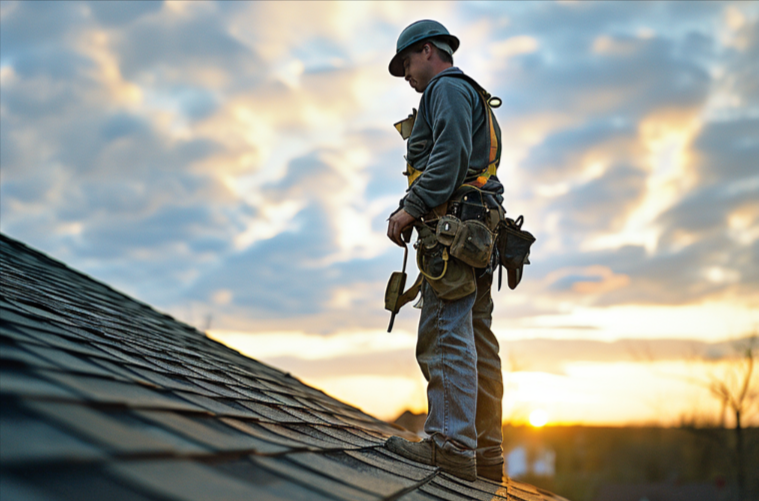
In the diverse world of roofing materials, membrane roofing stands out as a specialized solution particularly suited for flat or nearly flat roofs. Commonly seen atop commercial buildings and increasingly popular in certain residential applications, membrane roofing offers a unique combination of durability, weather resistance, and energy efficiency.
Types of Membrane Roofing
Membrane roofing systems come in various materials, each with unique properties and applications. Understanding these types helps in selecting the right roofing solution for your needs.
- Thermoset Membranes (EPDM):
- EPDM (ethylene propylene diene monomer) is a synthetic rubber roofing membrane known for its durability and versatility. It’s resistant to sunlight, heat, cold, and many chemicals, making it a long-lasting option for roofing. EPDM membranes are typically installed in large sheets, which reduces the number of seams and potential leak points.
- Thermoplastic Membranes (PVC and TPO):
- PVC (polyvinyl chloride) roofing is a thermoplastic membrane notable for its strength and resistance to water, fire, and chemicals. It’s often chosen for restaurants and other businesses due to its ability to withstand grease and oil.
- TPO (thermoplastic olefin) is another thermoplastic roofing membrane that has gained popularity due to its energy efficiency and ease of installation. TPO roofs are heat-welded at seams, creating a watertight bond that is strong and durable.
- Modified Bitumen:
- Modified bitumen roofing is an evolution of the old built-up roofing (BUR) systems but in a more convenient roll format. It combines layers of asphalt, reinforced with fiberglass or polyester, and is finished with a mineral-based surface. This type of membrane is known for its enhanced flexibility and stability in varying temperatures.
Each of these types offers distinct advantages and suits different roofing requirements, from heavy-duty commercial applications to modern residential solutions.
Advantages of Membrane Roofing
One of the most significant advantages of membrane roofing is its resilience. Materials like EPDM and TPO are particularly resistant to tears, punctures, and weathering, which contributes to their extended lifespan. These roofs can last up to 20-30 years with proper maintenance, offering a cost-effective solution for long-term roofing needs.
Additionally, many membrane roofing materials are designed to be highly reflective. This feature can significantly reduce cooling costs by reflecting sunlight and heat away from the building, a benefit that is especially notable in TPO and PVC roofing systems. Another appealing aspect of membrane roofs is their relatively low maintenance requirements. Compared to traditional roofing materials, they require less frequent repairs, although regular inspections are recommended to ensure their longevity.
Installation and Maintenance
The installation of membrane roofing is a specialized task that should be undertaken by professionals. The process typically involves laying out large sheets of the membrane material, securing them to the roof deck, and ensuring that all seams are properly sealed. For thermoplastic membranes like PVC and TPO, the seams are heat-welded to create a watertight bond. In contrast, EPDM membranes might be installed using adhesive or mechanical fasteners.
Regular maintenance and inspections are crucial for the longevity of a membrane roof. Periodic checks are necessary to identify and address any potential issues such as seam failures, punctures, or accumulated debris. While membrane roofs are known for their durability, addressing minor issues promptly can prevent them from escalating into more significant problems, ensuring the roof remains in optimal condition for years to come.
Challenges
When considering membrane roofing for a building, there are several factors to take into account. The initial cost of membrane roofing can be higher than some traditional materials, but this is often offset by its longer lifespan and lower maintenance costs. It’s important to evaluate the long-term savings in maintenance and energy efficiency against the upfront investment.
Another consideration is the suitability of membrane roofing for the specific climate and environmental conditions of the area. For instance, certain membrane materials perform better in extreme temperatures or in areas with high UV exposure. The flat or low-slope design of membrane roofs also makes them ideal for water drainage systems, but they require careful installation to ensure proper water runoff and avoid pooling.
Cost Considerations
The cost of membrane roofing varies depending on the type of material and the complexity of the installation. On average, materials like EPDM and TPO may cost more per square foot than traditional roofing materials, but their durability and energy-saving properties can make them more cost-effective in the long run. The cost of installation will also vary based on the size of the roof and the labor involved, especially for larger commercial projects. It’s advisable to get multiple quotes from professional roofing contractors to understand the full scope of the investment.
While pricing depends significantly on the exact situation, a standard 1,200-square-foot roof would translate to a total installation cost of approximately $3,00 to $8,000, excluding potential extra expenses like the removal of an existing roof, which can add $1.00 to $2.00 per square foot. For accurate pricing tailored to specific project needs, consulting with professional roofing contractors experienced in membrane roofing is recommended.
Conclusion
Membrane roofing represents a modern, efficient solution for flat and low-slope roofs, offering a blend of durability, energy efficiency, and low maintenance. While the initial costs may be higher than some traditional roofing options, the long-term benefits often justify the investment. Whether for a commercial building or a residential application, membrane roofing provides a reliable, long-lasting solution for protecting a property from the elements.
For those considering membrane roofing, it’s recommended to consult with professional roofing contractors who can provide detailed information and tailor a solution to the specific needs of the building and the local climate.





